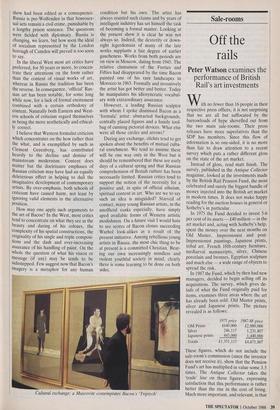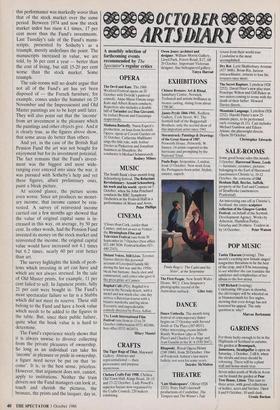Sale-rooms
Off the rails
Peter Watson examines the performance of British Rail's art investments
With no fewer than 16 people in their respective press offices, it is not surprising that we are all but suffocated by the barrowloads of hype shovelled out from the two main sale-rooms. Their press releases have more superlatives than the SDP has members. Since this flow of information is so one-sided, it is no more than fair to draw attention to a recent survey which puts a rather different gloss on the state of the art market.
Instead of gloss, read matt finish. The survey, published in the Antique Collector magazine, looked at the investments made by the British Rail Pension Fund, the most celebrated and surely the biggest bundle of money injected into the British art market in modern times. It does not make happy reading for the auction houses in general or Sotheby's in particular.
In 1975 the Fund decided to invest 5-6 per cent of its assets — £40 million — in the art market and, acting with Sotheby's help, spent the money over the next months on Old Master, Impressionist and post- Impressionist paintings, Japanese prints, tribal art, French 18th-century furniture, mediaeval manuscripts, silver, Chinese porcelain and bronzes, Egyptian sculpture and much else — a wide range of objects to spread the risk.
In 1987 the Fund, which by then had new managers, decided to begin selling off its acquisitions. The survey, which gives de- tails of what the Fund originally paid for items, examines three areas where the art has already been sold: Old Master prints, silver and Japanese prints. The picture revealed is as follows:
1975 price 1987-88 price
OM Prints £640,000 £2,000,000
ailpvaenrese prints
246,117 445,000 1,231,807 1,440,000 Totals £1,331,117 £4,671,807
These figures, which do not include the sale-room's commission (since the investor does not receive it), show that the Pension Fund's art has multiplied in value some 3.5 times. The Antique Collector takes the `trade' line on these figures, expressing satisfaction that this performance is rather better than the rise in the cost of living. Much more important, and relevant, is that
this performance was markedly worse than that of the stock market over the same period. Between 1974 and now the stock market index has risen 4.1 times, 17 per cent more than the Fund's investments. Last Tuesday's sale of the Fund's manu- scripts, presented by Sotheby's as a triumph, merely underlines the point. The manuscripts increased in value, we are told, by 36 per cent a year — better than the cost of living, but still 15-20 per cent worse than the stock market. Some triumph.
The sale-rooms will no doubt argue that not all of the Fund's art has yet been disposed of — the French furniture, for example, comes under the hammer on 25 November and the Impressionist and Old Master paintings are to be kept until later. They will also point out that the 'income' from art investment is the pleasure which the paintings and other objects give. And it is clearly true, as the figures above show, that some areas do better than others.
And yet, in the case of the British Rail Pension Fund the art was not bought for enjoyment but for its investment potential. The fact remains that the Fund's invest- ment was the biggest and most wide- ranging ever entered into since the war, it was pursued with Sotheby's help and yet these figures, albeit preliminary ones, paint a bleak picture.
At second glance, the picture seems even worse. Since art produces no monet- ary income, that income cannot be rein- vested. A survey of reinvested income carried out a few months ago showed that the value of original capital sums is in- creased in this way, on average, by 50 per cent. In other words, had the Pension Fund invested its money on the stock market and reinvested the income, the original capital value would have increased not 4.1 times but 6.2 times, nearly 60 per cent better than art.
The survey highlights the kinds of prob- lems which investing in art can have and which are not always stressed. In the sale of Old Master prints, for example, 11 per cent failed to sell. In Japanese prints, fully 21 per cent were bought in. The Fund's most spectacular failure so far is a Stubbs which did not meet its reserve. These still belong to the Fund and have a book value which needs to be added to the figures in the table. But, since their public failure, quite what the book value is is hard to determine.
The Fund's experience nicely shows that it is always unwise to divorce collecting from the private pleasures of ownership. So long as an individual can take his 'income' as pleasure or pride in ownership, a figure need never be put on that 'in- come'. It is, in the best sense, priceless. However, that argument does not, cannot, apply to institutions. Neither the train drivers nor the Fund managers can look at, touch and cherish the pictures, the bronzes, the prints and the lacquer, day in, day out, even if they wanted to. Investing in art thus becomes exactly the same as any other investment and needs to be seen in a colder light. A much colder light.




































































 Previous page
Previous page